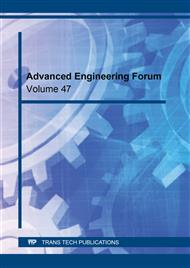[1]
J. Ortiz, Introducción a la oceanografía física, Del Norte University, Bogotá, (2015).
Google Scholar
[2]
Y. García, Geografía, Patria Publisher, México city, (2018).
Google Scholar
[3]
X. Morán, E. Vásquez, S. Ruíz, L. Arin, P. Raimbault, M. Estrada, Physical-biological coupling in the Algerian Basin (SW Mediterranean): influence of mesoscale instabilities on the biomass and production of phytoplankton and bacterioplankton. Deep-Sea Research 48 (2001) 405-437.
DOI: 10.1016/s0967-0637(00)00042-x
Google Scholar
[4]
P. Pérez-Brunius, P. García-Carrillo, J. Dubranna, J. Sheinbaum y J. Candela, Direct observations of the upper layer circulation in the southern Gulf of Mexico. Deep-Sea Research II 85 (2013) 182-194.
DOI: 10.1016/j.dsr2.2012.07.020
Google Scholar
[5]
M. Díaz, D. Salas, M. Monreal, Origin and evolution of cyclonic eddy of the Bay of Campeche, Gulf of Mexico, Revista de Biología Marina y Oceanografía, Vol. 52, N°3 (2017) 441-450 https://revbiolmar.uv.cl/resumenes/v523/523-441.pdf.
DOI: 10.4067/s0718-19572017000300003
Google Scholar
[6]
C. Valverde, Y. Valverde, Teoría de la energía sísmica, Aporte Santiaguino, 13(2020) 103-114.
DOI: 10.32911/as.2020.v13.n1.684
Google Scholar
[7]
American Chemical Society, Química, Reverté, Barcelona, (2005).
Google Scholar
[8]
C. Valverde, Y. Valverde «Teoría de la Energía Sísmica». Book of lectures XIX National Congress of Civil Engineering, vol. 1, Colegio de Ingenieros del Perú, Huaraz, 2015, pp.103-106.
Google Scholar
[9]
J. Wright, Medición y predicción de la radiación solar global UV-B bajo cielos claros y sin nubes, National University, Costa Rica, (2008).
Google Scholar
[10]
V. López Rodríguez, Electromagnetismo II, UNED, Madrid, (2016).
Google Scholar
[11]
J.R. Reagan, et al. Conductivity, in: World Ocean Atlas, NOAA Atlas NESDIS 86, Vol. 6, 2019. https://www.ncei.noaa.gov/sites/default/files/2021-03/WOA18_Vol6_Conductivity%20%281%29. pdf.
Google Scholar
[12]
R.A. Locarnini, et al., Temperature, in World Ocean Atlas 2018: Product Documentation. A. Mishonov, Technical Editor, Vol. 1, NOAA Atlas NESDIS 81, 2018. https://www.ncei.noaa.gov/sites/default/files/2021-03/woa18_vol1.pdf.
Google Scholar
[13]
https://sites.google.com/site/telurispnogues/home/antecedentes-y-marco-teorico.
Google Scholar
[14]
https://www.idstopografia.com/batimetrias-cartografiando-el-fondo-marino/.
Google Scholar



